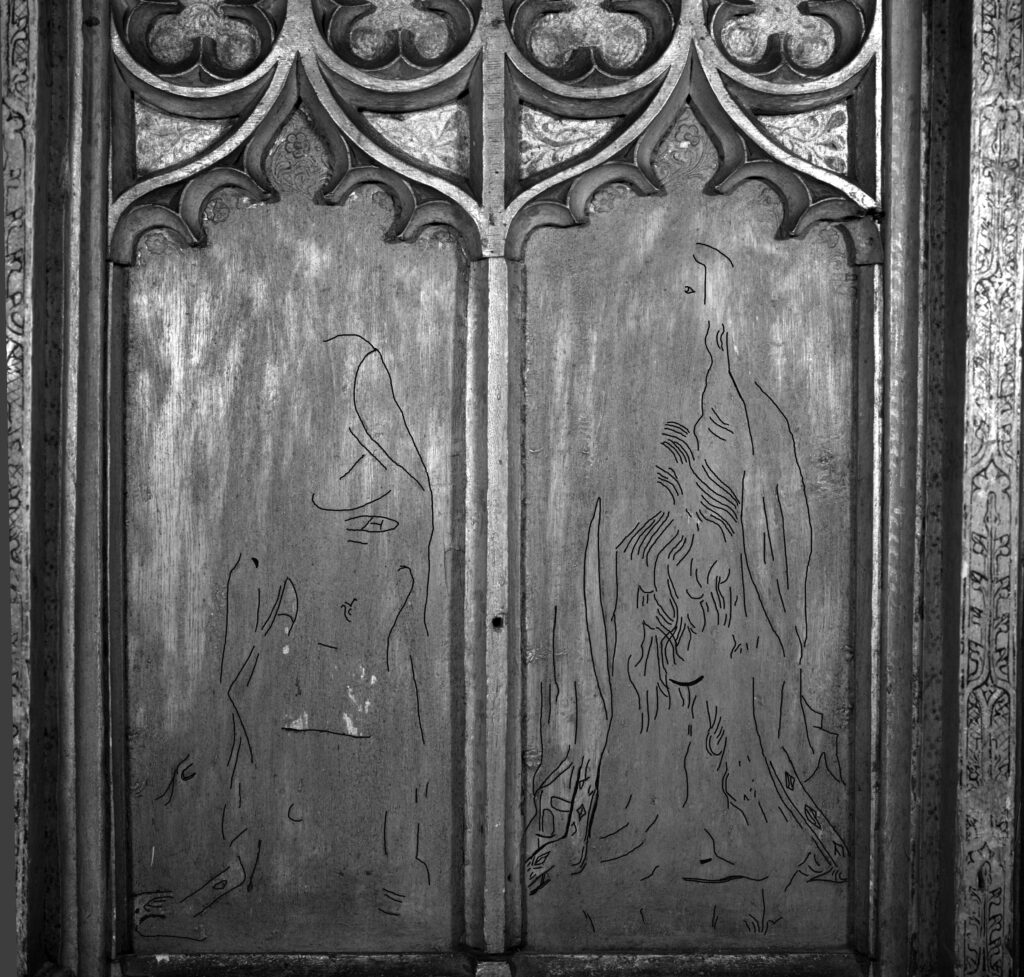
Norfolk and Suffolk have the most surviving late-medieval painted screens in England. Chancel or rood screens divided the nave from the chancel, the public part of the church from that of the priest. They were richly painted, with the figures of saints, prophets or angels placed along the dado of the screen.

The design and decoration of the rood screen at Barningham suggests a date of c. 1480-1500. There is a surviving will bequest from 1469 concerning land sold for the making of the candlebeam (an old Suffolk word for a rood screen). However, this was probably gifted to the church early in their fundraising for their rood screen, which has all the stylistic hallmarks of a later date.
At first glance, the panels on the screen appear blank. However, we know from the writing of Munro Cautley that, ‘Alas, the whole screen was varnished in 1933’. Close examination of the screen reveals more than one restoration over time, as well as other interventions. There are scratches where the faces of the figures on the flat panels once were an indication of iconoclasm in the Reformation or Civil War. The remains of original inscriptions can be seen on both the transom and the sill, but these have been painted over with an early paint, likely in the sixteenth or seventeenth century. There are also seventeenth-century doors, which might have been put on in the same restoration campaign.
Using an Apollo camera provided by Opus Instruments, it has been possible to see something of the figures which still lie underneath the many layers of overpaint and varnish. I have drawn the outlines of what I can see on the images taken with the camera. The Apollo camera photographs are useful in terms of the conservation of the screen because it enables the assessment of the current condition of the panels and guides the question of whether the overpaint would ever be removed.
From a technical perspective, it is also fascinating to learn more about the figures, which have not been identified before. What can we tell? Well for a start that the screen was originally decorated with figures and that at least some of them were saints, as can be seen from the remnants of haloes.

We can also see that the figures were standing on a grassy foreground, a design which was fairly common on rood screens. The backgrounds of the screens were decorated with a type of relief pattern. This is found on screens at Southwold and Yaxley in Suffolk and is usually a feature found in the sixteenth rather than the fifteenth century on screens.

The faces and the decorative relief backgrounds of the panels were already comprehensively damaged at the time the overpaint and varnish were applied, likely in more than one campaign as both abrasion, a rubbing down of the surface and a scratching of the surface are visible. Despite this damage, one of the figures is tentatively identifiable: St Margaret (second panel along on the north side). St Margaret can be identified from her saintly attribute – she is spearing a dragon – as well as her costume.

Another of the saints, the fourth panel on the north side (below), which frames the door, appears to be wearing a cloak but has a tunic either of hair or fur, or has hair covering their body. This could be St John the Baptist. However, the overpaint is too thick to be certain.

Opus Instruments would like to thank Dr Lucy Wrapson ACR, Senior Conservator at the Hamilton Kerr Institute and Fitzwilliam Museum for her findings.